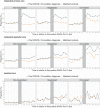Post COVID-19 condition diagnosis: A population-based cohort study of occurrence, associated factors, and healthcare use by severity of acute infection
- PMID: 36478477
- PMCID: PMC9877994
- DOI: 10.1111/joim.13584
Post COVID-19 condition diagnosis: A population-based cohort study of occurrence, associated factors, and healthcare use by severity of acute infection
Abstract
Background: The occurrence and healthcare use trajectory of post COVID-19 condition (PCC) is poorly understood. Our aim was to investigate these aspects in SARS-CoV-2-positive individuals with and without a PCC diagnosis.
Methods: We conducted a population-based cohort study of adults in Stockholm, Sweden, with a verified infection from 1 March 2020 to 31 July 2021, stratified by the severity of the acute infection. The outcome was a PCC diagnosis registered any time 90-360 days after a positive test. We performed Cox regression models to assess baseline characteristics associated with the PCC diagnosis. Individuals diagnosed with PCC were then propensity-score matched to individuals without a diagnosis to assess healthcare use beyond the acute infection.
Results: Among 204,805 SARS-CoV-2-positive individuals, the proportion receiving a PCC diagnosis was 1% among individuals not hospitalized for their COVID-19 infection, 6% among hospitalized, and 32% among intensive care unit (ICU)-treated individuals. The most common new-onset symptom diagnosis codes among individuals with a PCC diagnosis were fatigue (29%) among nonhospitalized and dyspnea among both hospitalized (25%) and ICU-treated (41%) individuals. Female sex was associated with a PCC diagnosis among nonhospitalized and hospitalized individuals, with interactions between age and sex. Previous mental health disorders and asthma were associated with a PCC diagnosis among nonhospitalized and hospitalized individuals. Among individuals with a PCC diagnosis, the monthly proportion with outpatient care was substantially elevated up to 1 year after acute infection compared to before, with substantial proportions of this care attributed to PCC-related care.
Conclusion: The differential association of age, sex, comorbidities, and healthcare use with the severity of the acute infection indicates different trajectories and phenotypes of PCC, with incomplete resolution 1 year after infection.
Keywords: COVID-19; SARS-CoV-2; long-term outcomes; post COVID-19 condition; sequelae.
© 2022 The Authors. Journal of Internal Medicine published by John Wiley & Sons Ltd on behalf of Association for Publication of The Journal of Internal Medicine.
Conflict of interest statement
The authors declare that there is no conflict of interest that could be perceived as prejudicing the impartiality of the research reported.
Figures




References
-
- WHO Headquarters (HQ) . A clinical case definition of post COVID‐19 condition by a Delphi consensus, 6 October 2021. https://www.who.int/publications/i/item/WHO‐2019‐nCoV‐Post_COVID‐19_cond... (2021). Accessed 10 Jan 2022.
Publication types
MeSH terms
LinkOut - more resources
Full Text Sources
Medical
Miscellaneous

